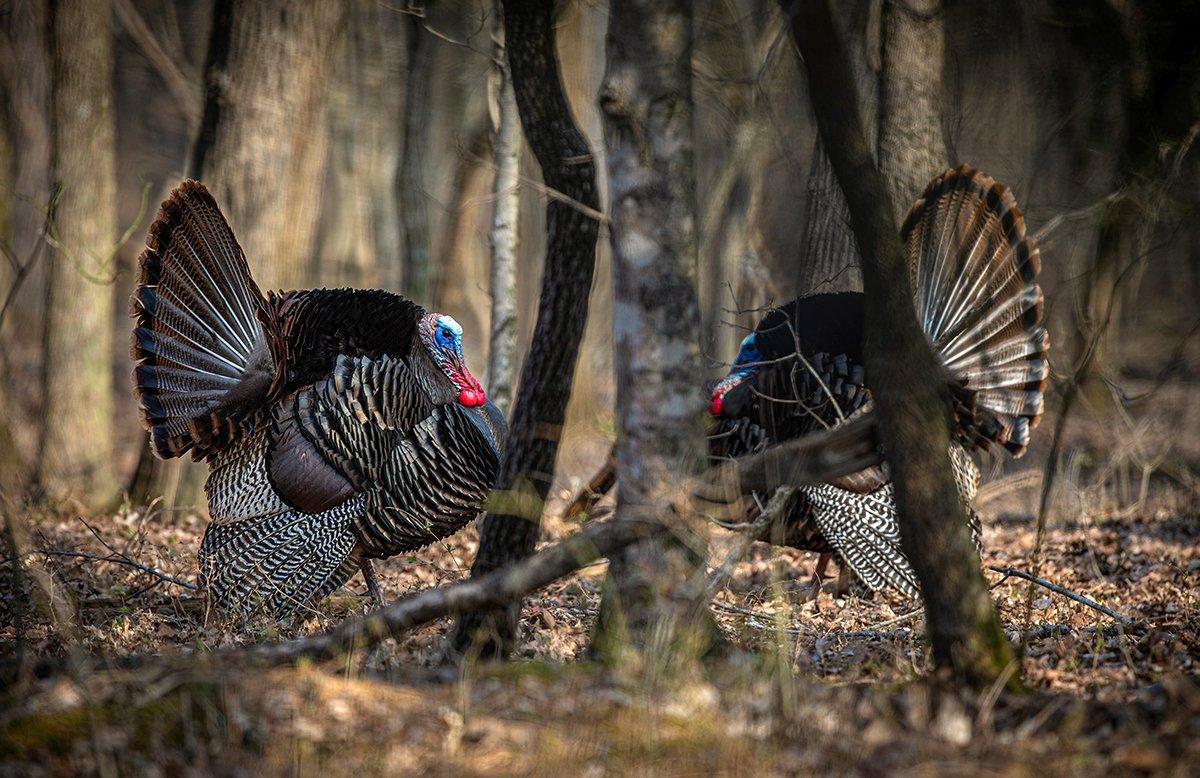Afraid of heights? Some tips for getting on ridge-running gobblers
I half-slept a few hours, drove four more, parked, shouldered my vest, and eased up the Vermont mountain. Darkness receded into dingy light from where I sat near a dry creek bed. I squinted and saw a longbeard silhouetted high in the oak not far away. Yep, maybe too close.
The mountain bird winged down and gobbled hard, and I watched as hens came running. For the rest of the morning, while other turkeys hammered on the far hillside, I followed that pack of birds up, down, and around steep terrain, calling to them in vain — and they were always just a little ahead of me.
And stayed that way. Mountain turkeys don't give a gobble if you need some rest, and your truck tires are wearing down.
Field Strutters Versus Ridge Runners
A field strutter often roosts within a fly-down or walk-to-strut zone. Hens are likely nearby, or that gobbler will try its best to call some in. Its range is tighter, sometimes more predictable, flatter on foot.
In a pasture situation, strategies can be nicely honed down. You can get even tighter on the roost site as spring leaf-out flourishes. You can hunt a pinch point, waiting for turkeys to enter a field in a specific spot.
A mountain gobbler also wants to be near hens and a strut zone — a space often defined as a movable target wherever those hill-walking hens want to go. And where the hens want to go there are many escape routes, varying elevations, feeding areas, and even shifting roost locations.
Unlike the pasture bird, a mountain strutter has more room to travel. Its daily rounds might exceed that low-level turkey's ground coverage. Pinch points are limited, or many, depending on what ridge top or side hill or creek bottom you share with that turkey.
Turkeys in elevated country sometimes drop down to fields. Hens might take a strutter there as they feed, and the full-fan bird follows. To use a baseball analogy, the pitch count weighs in their favor.
[Don't Miss: Long Distance Turkey Calling]
Time the Arrival
If you hunt out West, you know Merriam's will often choose to strut and feed in a high meadow, sometimes only approachable by a skinny game trail tattooed with elk, mountain lion, and yes, turkey tracks. Those field strutters might be high up after a climb. But then the situation becomes like just any other pasture location you might hunt back East. Unless they roost off that open area, then fly down to side hills — or move there later in the day.
In this situation, it becomes a matter of roosting, patterning, and timing the birds on their daily travels.
If the turkeys roost down low or on a side hill, but then move higher after fly-down, be up above them well before then, waiting on their arrival. A windy blow can push turkeys out of open areas into sanctuaries with relative protection from the elements. A weather event with wind might do this too, as Western hunts, even in May, can include snowfall and gusty stretches. In both scenarios, the daily travels of these mountain birds might qualify the flock as ridge runners and field birds.
And if you're more of the run-and-gun type, a hunter who likes to head off and get ahead of mountain Merriam's, more in the way of Western elk or deer hunts, patterning birds matters a lot.
It's all about where you make your setup, waiting on them to arrive.
[Don't Miss: How to Kill Turkeys in Any Weather]
Bottom of the Ninth
As mentioned earlier, where a gobbler roosts — along with the hens or jakes running with it —will dictate how you might rally to put a tag on a mountain strutter.
Longbeards roosted in steep terrain have the advantage of watching over a big expansive area below them on the roost, even as they strut in a preferred zone. This puts you at a tremendous disadvantage as far as setting up goes.
If anything, you need to stake your claim early — even if you hear the turkey fly down and go the other way. It has a lot of room to do this, after all. But once you hunt this bird enough, you'll begin to see smaller areas where it hangs out. This will help you get closer.
But don't rush to the bird once you think you've got that mountain strutter's position nailed. Move slowly, with tremendous deliberation. Every step and stop should put you in the next position to set up and call the gobbler in. Break your maneuvers down into tactical stages. Use trees, benches, brush, and hilly rises to get closer and closer. And never, ever go to a bird if it can see you coming.
If it hears you coming is another thing. The hard-gobbling turkey might listen to your footsteps in the leaves and think it's a hen approaching. So, stay tuned in to that constant possibility.
[Don't Miss: 3 Ways to Make a Gobbler Do What You Want]
Walk-Off Game Winner
The beauty of mountain turkeys is some will give you fits, and others will allow you to slip right in and call one up.
By midmorning, I gave up on those Vermont birds mentioned at the start of this blog. And I dropped down the steep incline and crossed over to the far hillside where birds had hammered since daybreak — and still were as I approached to try and yelp one in.
And I called one up into range instantly. Mountain turkeys are like that.
What makes Realtree.com the best online resource for turkey hunters? See for yourself. We cover all things turkey right here.








